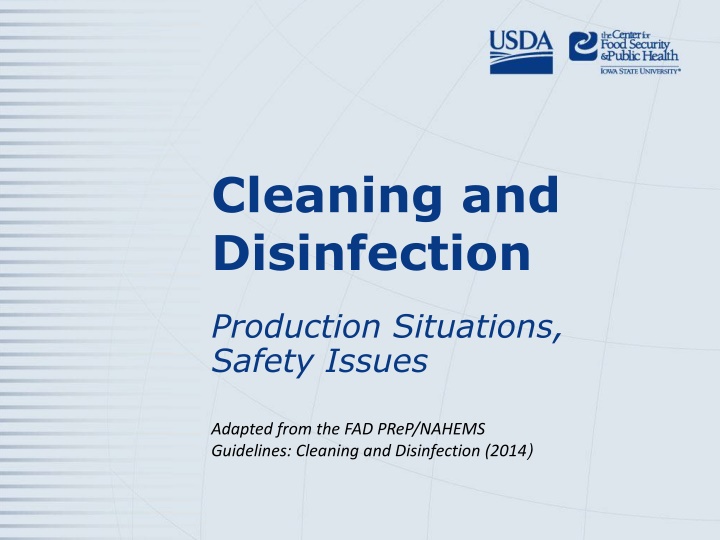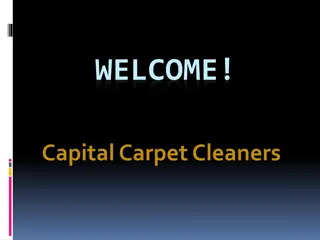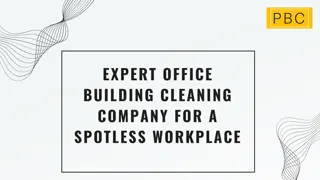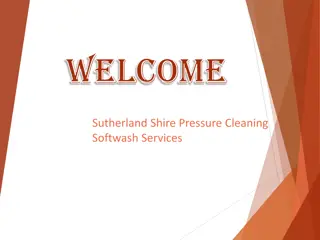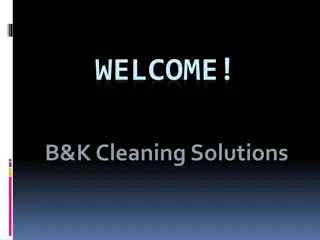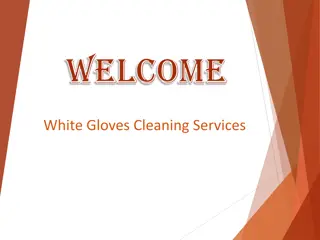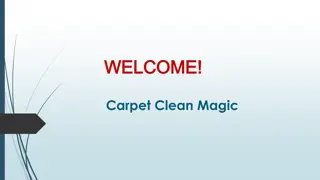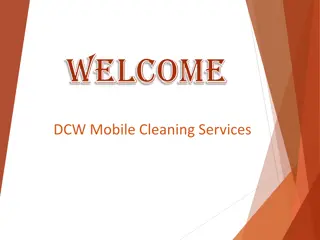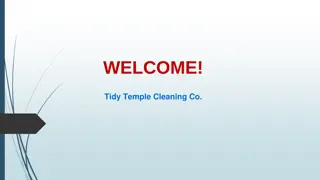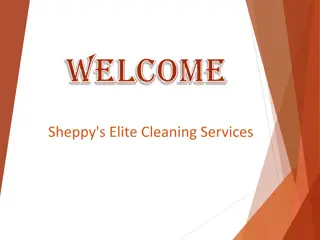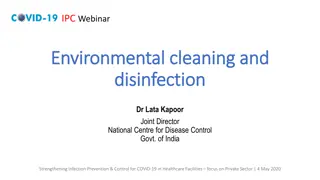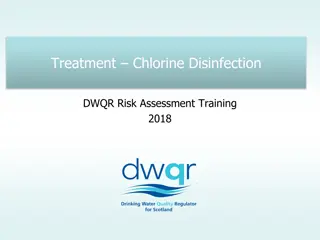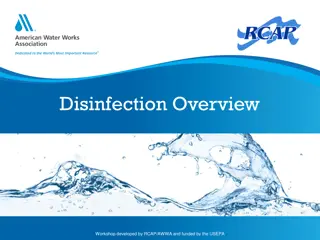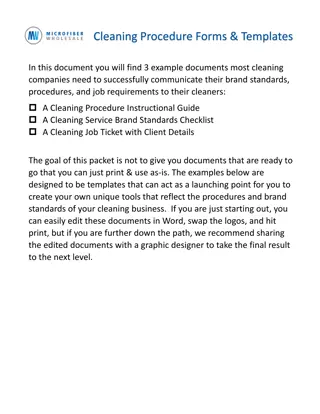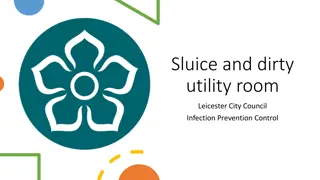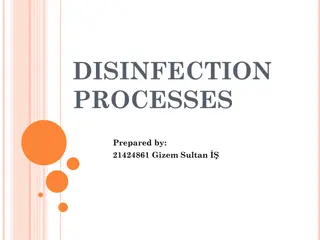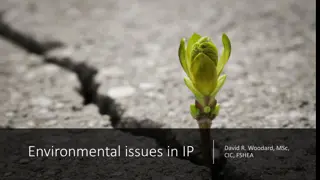Guidelines for Cleaning and Disinfection in Animal Production Facilities
Explore key guidelines for cleaning and disinfecting various animal production facilities, including poultry, dairy, swine, equine, and aquaculture. Specific challenges and safety considerations for each type of facility are discussed, highlighting the importance of using appropriate products and techniques to prevent disease spread.
Download Presentation

Please find below an Image/Link to download the presentation.
The content on the website is provided AS IS for your information and personal use only. It may not be sold, licensed, or shared on other websites without obtaining consent from the author.If you encounter any issues during the download, it is possible that the publisher has removed the file from their server.
You are allowed to download the files provided on this website for personal or commercial use, subject to the condition that they are used lawfully. All files are the property of their respective owners.
The content on the website is provided AS IS for your information and personal use only. It may not be sold, licensed, or shared on other websites without obtaining consent from the author.
E N D
Presentation Transcript
Cleaning and Disinfection Production Situations, Safety Issues Adapted from the FAD PReP/NAHEMS Guidelines: Cleaning and Disinfection (2014)
Poultry Premises Multiple areas, varied equipment Housing, nesting boxes Open floor areas Require removal of litter and manure prior to disinfection Egg storage rooms Egg processing equipment Egg belts, flats, buggies, packing machines Curtains 3 FAD PReP/NAHEMS Guidelines: Cleaning and Disinfection - Production & Safety USDA APHIS and CFSPH
Dairy Facilities Unique challenges include: Milking equipment Milking units, strainers, coolers, bulk tank Milk-film or deposits Must use products labeled for food contact surfaces Seek assistance from dairy manager 4 FAD PReP/NAHEMS Guidelines: Cleaning and Disinfection - Production & Safety USDA APHIS and CFSPH
Swine Facilities Special situations: Farrowing pens, slats, alleys, slurry pits Bars, crates, gates Electrical equipment Clean and disinfect without leaving residual chemicals Avoid phenolic disinfectants 5 FAD PReP/NAHEMS Guidelines: Cleaning and Disinfection - Production & Safety USDA APHIS and CFSPH
Equine Facilities Environments highly variable Pastures, paddocks, porous materials Must remove organic debris Use products labeled for surfaces Wood, concrete Use exempted pesticide if registered product not available 6 FAD PReP/NAHEMS Guidelines: Cleaning and Disinfection - Production & Safety USDA APHIS and CFSPH
Aquaculture Facilities Special considerations include: Chemical product runoff Disinfection of transport boats, other water equipment Chlorine and iodine, neutralize with sodium thiosulfate 7 FAD PReP/NAHEMS Guidelines: Cleaning and Disinfection - Production & Safety USDA APHIS and CFSPH
Prions Highly resistant Disinfectants, heat, UV, ionizing radiation Physical inactivation Autoclaving 134-138oC for 18 minutes at 30 lb/in2 Not practical No products registered/exempted by EPA for agricultural facilities Exemption would be needed 8 FAD PReP/NAHEMS Guidelines: Cleaning and Disinfection - Production & Safety USDA APHIS and CFSPH
Evaluation Inspection of a site by experienced personnel All contaminated areas/equipment C&D d Fixtures/fittings dismantled Disinfectant at proper concentration and contact time Gross debris (manure, bedding) disposed Other items disposed in a biosecure manner Effluent avoids environmental impact Disinfection measures repeated, if necessary 9 FAD PReP/NAHEMS Guidelines: Cleaning and Disinfection - Production & Safety USDA APHIS and CFSPH
Safety Issues and Precautions 10
Chemical Hazards Chemical disinfectants have health hazards or risks All products must be used with care and appropriate PPE Prepare and store disinfectants as directed Rinse areas thoroughly before reintroducing animals 11 FAD PReP/NAHEMS Guidelines: Cleaning and Disinfection - Production & Safety USDA APHIS and CFSPH
Physical Hazards Physical hazards may include: Slippery conditions High pressure sprayers Steam or flame Dust More information in the Health and Safety Guidelines 12 FAD PReP/NAHEMS Guidelines: Cleaning and Disinfection - Production & Safety USDA APHIS and CFSPH
Biological Hazards Zoonotic diseases C&D conducted in contaminated areas Sweeping, scraping, blowing may disperse pathogen Inhale, ingest, direct contact Avoid exposure with careful C&D measures and PPE 13 FAD PReP/NAHEMS Guidelines: Cleaning and Disinfection - Production & Safety USDA APHIS and CFSPH
Personal Protective Equipment Minimum PPE required during C&D procedures Coveralls, boots, gloves Additional PPE includes: Goggles Face shields Respiratory protection Dust masks/respirators Waterproof or chem-resistant suits 14 FAD PReP/NAHEMS Guidelines: Cleaning and Disinfection - Production & Safety USDA APHIS and CFSPH
Hazard Communication All C&D team members should have a complete orientation covering potential hazards Complete understanding of specific safety precautions must be obtained before entering premises 15 USDA APHIS and CFSPH FAD PReP/NAHEMS Guidelines: Cleaning and Disinfection - Production & Safety
For More Information FAD PReP/NAHEMS Guidelines & SOP: Cleaning and Disinfection http://www.aphis.usda.gov/fadprep Cleaning and Disinfection web- based training module http://naherc.sws.iastate.edu/ 16 FAD PReP/NAHEMS Guidelines: Cleaning and Disinfection - Production & Safety USDA APHIS and CFSPH
Guidelines Content Authors (CFSPH) Glenda Dvorak, DVM, MS, MPH, DACVPM Nichollette Rider, Junior Veterinary Student Reviewers (USDA) Nathan G. Birnbaum, DVM Samantha B. Floyd, Biologist 17 FAD PReP/NAHEMS Guidelines: Cleaning and Disinfection - Production & Safety USDA APHIS and CFSPH
Acknowledgments Development of this presentation was by the Center for Food Security and Public Health at Iowa State University through funding from the USDA APHIS Veterinary Services PPT Authors: Dawn Bailey, BS; Kerry Leedom Larson, DVM, MPH, PhD, DACVPM; Reviewers: Glenda Dvorak, DVM, MPH, DACVPM; Patricia Futoma, Veterinary Student; Janice Mogan, DVM
